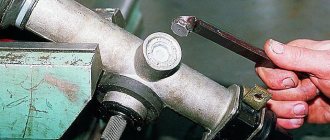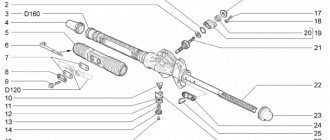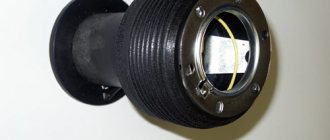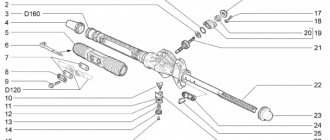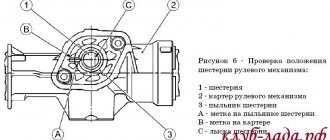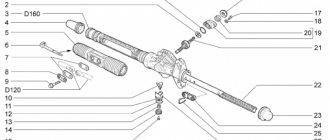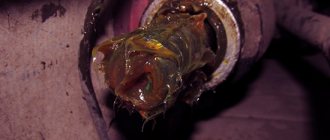Rack and pinion steering mechanisms have significant advantages over other types on relatively light vehicles. These are high control accuracy, simplicity and compactness of design, and the possibility of fairly simple pairing with all classes of power steering.
Reliability and durability are also satisfactory, but largely depend on timely maintenance and adjustment work. One of them is to eliminate by tightening the resulting play in the internal gearing, which is possible on a number of manufactured mechanisms.
How to tighten the steering rack. Foreign car + our VAZ, there will also be a video
Over time and from our wonderful roads, the steering rack begins to wear out. This manifests itself as - she simply starts knocking. Many people go to a service station, where the mechanic, rubbing his hands, states that you need to repair it! By the way, this is a standard scam, but many people don’t know that the rack can be tightened on many cars. Moreover, this is done quite easily and simply. Personally, I pulled it up once on my former VAZ 2114 - really, everything is done in literally an hour or two. Today I want to present you with detailed instructions...
Yes, guys, if it starts knocking, not too much, but you know those rattles on bumps, then first try tightening the VAZ by 90%; the knocking will go away for quite a long time. And on many foreign cars, this knock can also go away if there are adjusting screws. BUT first, let's think about why the knocking occurs.
Tightening the steering rack involves interacting with that part of the mechanism through which force is transmitted from the steering shaft to the rack. In general, the force after turning the steering wheel is transmitted using a helical or spur gear that meshes with a rack.
The gear is mounted on a bearing. In this case, the pressure of the gear to the toothed part should be tight (without gaps). For this reason, additional pressure springs are installed.
- If the rack-and-pinion pair is out of adjustment, it may require more effort from the driver to turn the steering wheel. In this case, you need to loosen the pressure of the gear to the toothed part, replace the lubricant, etc.
- If the rack is loose, there is a loosening of the fastening of the rack housing, the mounting bracket for the crankcase lever and the steering bipod, you can remove the knocking and play by tightening it.
Moreover, even if you tighten the steering rack correctly, this is a temporary solution. After several tens of thousands of kilometers, the driver will again encounter play and knocking in the rack. In this case, secondary tightening of the adjusting nut is not recommended. It is necessary to carry out a complete repair of the steering mechanism or replacement of the rack.
Recommendations
After completing the adjustments, the rack should also be checked while running. It is important to pay attention to the fact that after turning the steering wheel, the steering wheel itself must return to the zero position (steering wheel straight) without driver assistance. If you have to turn the steering wheel by hand (the steering wheel does not return to zero), this indicates obvious problems with the rack (too tight the adjusting nut, wedging, etc.).
We also recommend reading the article about what electric power steering is. From this article you will learn about the features, as well as the pros and cons of electric power steering.
You can accurately check this nuance on a straight section of road with a good road surface without defects. Please note that when checking you need to be careful and careful! If there is no suitable site or you are not confident in your abilities, it is better to refuse these tests.
To check the steering return, just go through a turn and, at the exit of it, press the gas, briefly removing your hands from the steering wheel. If the steering wheel does not tend to return to the zero position and needs to be turned independently, then the nut on the rack may be overtightened and needs to be loosened.
Features of adjusting the Renault Logan rack
We remove the boot clamp that protects the steering rack from dirt and dust, for which we simply cut it off with wire cutters. The place where the steering rack on a Renault Logan with power steering is tightened is on the left side. There is a special tightening bolt that you need to get to. It is located directly under the steering shaft, and repairing the rack involves tightening the adjusting bolt slightly to increase the pressure of the spring, which presses the shaft gear against the rack.
The adjusting bolt, located on the left side of the rack, is recessed into the body; if it is flush with the body, this indicates that it is not tightened and it is possible to remove play in the steering rack by tightening it to a certain angle. If the backlash is not eliminated when the bolt is fully tightened, a more expensive repair of the steering rack will be required, up to and including its complete replacement. On the right side of the rack there is a special bushing that seals it in the middle of the body, and when inspecting the car, it is advisable to check its integrity so that dust or dirt does not get into the middle of the mechanism.
Let's sum it up
For high-quality operation of the car, it is necessary to service the vehicle in an excellent service center, where specialists can perform all the required procedures. But sometimes cooperation with professionals is impossible; you need to quickly fix the problem and continue moving. Now you can adjust the rack yourself by tightening the adjusting nut. But keep in mind that such an action will not return the device to excellent performance. After a short time, you may experience the problem of a knocking or increased play in the steering wheel.
The best option to repair this problem is to replace the steering rack along with the tips. But sometimes repairs will allow the mechanism to return to high-quality operation. If you have experience working with the steering rack yourself, we will be glad to learn about it from the comments to the publication.
Background
An unpleasant characteristic dull knock appeared when driving this car, especially felt when driving over uneven roads. Hearing such a knock, Logan's owner stopped by one of the service centers, where he was diagnosed - the steering rack was knocking and required replacement.
In our service center, we decided to double-check the diagnosis of the previous “servicemen” to make sure that the steering rack really requires replacement.
If the rack is knocking, then first we will try to adjust the Renault steering rack and show you how to do it correctly.
Go
We lift the car on a lift and begin to inspect it.
First, we check for play by shaking the front wheels. Next, we check the steering rack itself. To do this, grab the body of the steering rod with your hand and rock it up and down.
There is undoubtedly some play when rocking; it is small, but it is there. However, the knocking noise we heard during the test drive was of a completely different nature. Upon inspection, we immediately saw the reason for the additional knocking, in addition to the knocking coming from the steering rack.
It is visually clear that there is a gap between the left bushing of the transverse stabilizer and the body of the subframe, which was the reason for the additional knocking. By shaking the body of the stabilizer, we make sure that there is play. When the car is raised, the knock is not heard, since the stabilizer is pulled back and the bushing on the right is still “alive”.
When the car is not on a lift, when rocking, a dull knock is clearly audible and precisely on the left side.
About the procedure for tightening the adjusting plug, you must clearly understand that this is not a panacea and will not eliminate the problem itself 100%. In addition to cases of knocking of the steering rack and large play, on cars with low mileage, when the pressed plug was unscrewed, only tightening and fixing it was necessary. Probably, it was poorly sealed, and there was little lock, which is why the plug gradually unscrews due to body vibration while driving.
Tightening the rack with removal
Immediately arm yourself with a steering rack wrench specialized for the “ten”, and also get ready to remove the rods. From the tools, grab:
- Pliers;
- Mounting blade;
- Socket wrench 19;
- Hammer;
- Flat screwdriver;
- Set of heads - from 10 to 27.
Get started:
- Unscrew the nuts inside the passenger compartment and remove the fastening bolts of the lower universal joint to the steering rack gear shaft. To do this, you will need a 13mm socket. The bolt can turn, so hold it with an open-end wrench.
- In the engine compartment itself, remove the nut of the upper fastening of the rack boot.
- At the bottom of the car, remove two more nuts that secure the rack boot.
- Remove the boot.
- Raise the front of the car and remove the front wheels.
If you are going to remove the steering, but not dismantle the rods, follow these instructions:
- Remove the locking plate from the rod mount by prying it off with a screwdriver. Then unscrew the two bolts that secure the rods and rack;
- Using a 13mm socket, remove the nuts from the steering gear brackets connecting to the front panel;
- Move the rack forward a little to remove the gear shaft from the shield hole;
- Remove the rack together with the rods.
If you want to remove the steering rods, unscrew the rod end from the swing arm of the shock absorber struts. To do this you will have to do the following:
- Remove the cotter pin using pliers;
- Using a 19mm spanner, unscrew the ball pin fastening nut, but not all the way;
- Use a 17 socket to loosen the tension bolt of the rod end;
- Now press out the ball pin. To do this, insert a mounting blade between the swing arm and the tip. Press the tip away from the lever, and apply several blows with a hammer to the end of the rotary lever;
- Unscrew the ball stud nut completely;
- Remove the ball pin from the lever hole;
- Use a screwdriver to open the groove of the tie rod end;
- Remove the tip, holding the threaded adjusting sleeve with a 27mm wrench. Count the number of turns so that during reassembly you can tighten it by the same number of turns;
- On the tie rod, try to maintain the position of the threaded bushing. This way the toe angle of the wheels will remain as correct as possible.
Why tighten the rack on a VAZ-2114
Diagnostics of the steering rack and steering mechanism
Before tightening the steering rack on a VAZ-2114, it is worth considering the prerequisites that will tell you that it’s time to repair or tighten it.
In principle, AvtoVAZ guarantees a fairly long service life of the steering mechanism, namely ten years . However, we must understand that we are talking about ideal operating conditions. This assumes smooth asphalt roads, constant availability of high-quality lubrication in the rack housing and a gentle driving style.
Under normal operating conditions, this period is practically unattainable. Unimportant roads, poor quality of spare parts and often harsh operating conditions of the car lead to the fact that the mechanism makes itself felt much earlier.
The first symptoms of a faulty steering mechanism on a VAZ-2114
The first symptoms of a rack malfunction or the need for tightening are clear:
- Knocking noise under the hood in the area of the engine shield, especially when driving over uneven surfaces.
On a VAZ-2114, a knocking sound when driving through uneven sections of the road may occur due to a loose nut on the bolt that compresses the cardan clamp
The latter can be considered a glaring signal of malfunction and can lead to serious troubles while driving.
In this case, most likely, tightening the situation will not correct the situation, however, it is too early to draw conclusions, you can try to adjust it. This can be done in two ways - both on the car and with the rack removed.
Complete disassembly of the steering rack and replacement of the repair kit
In the second case, the adjustment is made after replacing the repair kit and completely repairing the mechanism. We will try to make do with little expense and simply adjust the gap in the gear-rack engagement , thereby eliminating backlash and knocking.
We tighten the tie rod mounts and check the ends
Often, knocking in the steering rack area is not caused by a breakdown or wear of the rack mechanism itself. If you have tightened the adjusting nut to the point where the steering wheel begins to exhibit unusual rigidity, but knocks are still present, you should loosen the nut on the rack a little. The problem most likely lies in the tie rod ends and tie rods. Everything is much simpler here - you need to tighten the fastenings of the rods and tips completely to eliminate play.
There are several options for attaching tips. The most common are a hexagon, a design for a tubular wrench with a lock nut, or a special mount for a screwdriver. An ordinary screwdriver will not help in this matter, and the ideal tool would be a standard wheel nut wrench, the reverse side of which is made in the form of a large screwdriver. Steering ends should be tightened taking into account some features:
- When tightening the fastening of the tip, you need to firmly fix the entire mechanism, otherwise you can easily knock off the wheel alignment;
- it is necessary to tighten until it stops, but do not overtighten;
- after tightening the tip bolts, it may be necessary to check the wheel alignment;
- If the knocking still persists, the problem is either in the inside of the rack or in the steering rods.
It is not recommended to tighten the tie rod fastenings yourself, and you should not try to repair the rack yourself. Even dismantling and correct subsequent installation of this device can cause quite a lot of problems. You should immediately contact a specialized service to receive specialist services and forget about problems with this unit.
The service center often recommends replacing the steering rack. But if you have a fairly expensive car from a renowned manufacturer, a high-quality part and the work to replace it will be very expensive. In this case, it is better to use the services of professionals and repair the rack. True, after repair the mechanism will no longer serve as long as a new steering rack does.
Sometimes repair and restoration of the rack is impossible. The Korean car from the following video has a completely unique problem, but not an isolated one.
Video:
The principle of operation of the mechanism
Before starting any repair work on the car, it is necessary to find out the operating principle of a particular mechanism. The steering rack is needed to transfer the physical forces applied by the driver when turning the steering wheel to a helical gear located on a bearing. Pressure springs guarantee high-quality contact between the gear and rack.
Adjusting the steering rack is an inherently simple task, and any driver can handle it. On average, this procedure takes from 1 to 2 hours, taking into account the preparatory activities. In what cases is such a lift required?
In what cases is it necessary to adjust the steering rack?
Distributor housing wear
In the vast majority of cases, tightening the steering rack is required if there is knocking and play in this mechanism. However, you need to be aware that such repairs do not always help. These malfunctions may indicate banal wear of the gear or rack or its individual parts.
Tapping and pronounced play in the steering rack often occur for the following reasons:
- the transmitting pair (its engagement zone) requires adjustment and adjustment;
- there is a loosening of the fixation of the lever bracket, steering system housing, bipod;
- natural wear and tear of parts, ball joints.
A properly adjusted steering mechanism will eliminate any knocking and improve the comfort of driving an aged car. Therefore, if you notice that the car’s steering wheel turns tightly, you should not limit yourself to tightening the corresponding device; it is strongly recommended to add lubricant to the crankcase.
How to make adjustments
The principle of operation of the unit is based on the displacement of the bar using a gear. Steering rods are mounted at the edges of the bar. They are connected to wheel mechanisms. When the steering wheel rotates, the gear located on the shaft moves the bar with teeth in the desired direction.
To eliminate play in the rack, the elements of the gear pair are pressed tightly against each other. In this case, the steering wheel rotates freely without applying much physical effort. Surface wear leads to incorrect operation of the unit.
How to adjust it yourself
The steering rack can be adjusted independently. To do this, you should prepare the appropriate tool.
What do you need to tighten up?
Before you start work, you need to worry about a partner who will help in repairing the car, and also watch videos on the Internet on this issue. It is also necessary to stock up on an electronic playmeter. According to GOST, the steering play should not be more than 10°. To carry out these, you need a garage with a pit and a lantern for lighting.
The mechanism will be adjusted with a special key for tightening. If there is no hole in the garage, you will need a jack. After lifting it, the machine should be fixed on the lifting trestles for support and only then inspect the mechanisms in order to tighten the rack.

